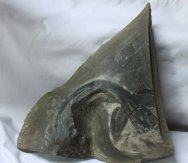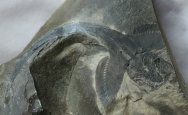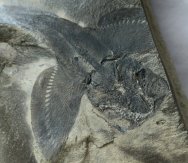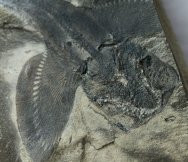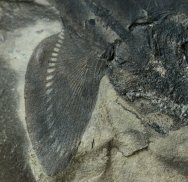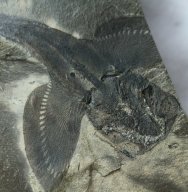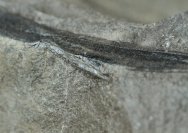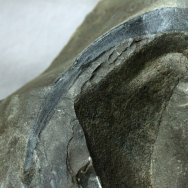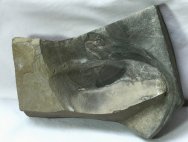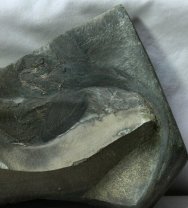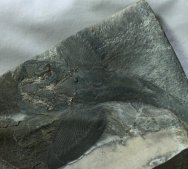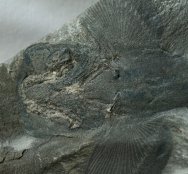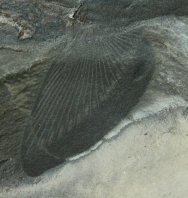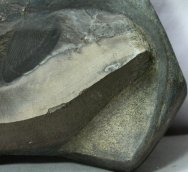| 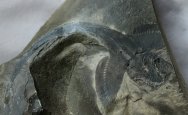 The Bear Gulch Limestone is a deposit of some 70 square km
in extent and 30 m in depth that has been a source of one of the
most diverse assemblages of fossil fish with some 110 species having
been described over the past 30 years. Most were new to science,
and provided a unique view of the marine environment of Mississippian
times. Fine preservation of both fish and invertebrates is a hallmark
of these deposits, presumably due to an anoxic depositional environment. The Bear Gulch Limestone is a deposit of some 70 square km
in extent and 30 m in depth that has been a source of one of the
most diverse assemblages of fossil fish with some 110 species having
been described over the past 30 years. Most were new to science,
and provided a unique view of the marine environment of Mississippian
times. Fine preservation of both fish and invertebrates is a hallmark
of these deposits, presumably due to an anoxic depositional environment.
This
specimen is a most unusual shark with a batoid morphology. This
is the first example found by my field 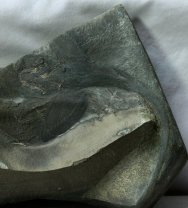 collector
in a 30 year career, and joins only THREE OTHERS I know about
in the literature.
To date no evidence of pelvic fins has been found. While the
other specimens were in part less complete, the degree of preservation
seen here seems indicative that it did not have them. It presumably
sculled along the bottom seeking prey. Note the incredible details
to the fin rays and coloration, as well as the skeletal structure,
amazing for a specimen composed of cartilage. The Gill structure,
eyes, vertebral column, dermal denticles, and jaws are all readily
seen. Note too the robust shoulder girdle that supported the
flambouyant
pectorals. The teeth are most likely contained within the jaw
cartilage, and are indicated by the nodules contained therein.
Note also the
spine in the tail which is exposed at the side of the matrix
that is the source of the species name and the lateral line canal
which
extends along the posterior third of the tail. Restoration has
been minimal: both sides have had repairs to the matrix. The
A side (above left) has a restoration to the tip of the complete
pectoral and
tail and a small portion of the tail where a natural crack resulted
in loss of material, while the B side (above right) has had the
tail restored. I will be glad to supply photos from the preparator
that detail
the restoration as outlined. collector
in a 30 year career, and joins only THREE OTHERS I know about
in the literature.
To date no evidence of pelvic fins has been found. While the
other specimens were in part less complete, the degree of preservation
seen here seems indicative that it did not have them. It presumably
sculled along the bottom seeking prey. Note the incredible details
to the fin rays and coloration, as well as the skeletal structure,
amazing for a specimen composed of cartilage. The Gill structure,
eyes, vertebral column, dermal denticles, and jaws are all readily
seen. Note too the robust shoulder girdle that supported the
flambouyant
pectorals. The teeth are most likely contained within the jaw
cartilage, and are indicated by the nodules contained therein.
Note also the
spine in the tail which is exposed at the side of the matrix
that is the source of the species name and the lateral line canal
which
extends along the posterior third of the tail. Restoration has
been minimal: both sides have had repairs to the matrix. The
A side (above left) has a restoration to the tip of the complete
pectoral and
tail and a small portion of the tail where a natural crack resulted
in loss of material, while the B side (above right) has had the
tail restored. I will be glad to supply photos from the preparator
that detail
the restoration as outlined.
References:
Annals
of the Carnegie Museum, Volume 45, pp 43-55, Dec 27,1974
Journal of Vertebrate Paleontology, Volume 8, pp 340-343, Sept
1988.
|


